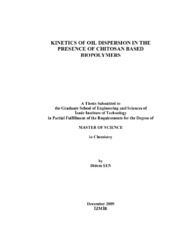Please use this identifier to cite or link to this item:
https://hdl.handle.net/11147/3075Full metadata record
| DC Field | Value | Language |
|---|---|---|
| dc.contributor.advisor | Polat, Hürriyet | en |
| dc.contributor.author | Şen, Didem | - |
| dc.date.accessioned | 2014-07-22T13:50:50Z | - |
| dc.date.available | 2014-07-22T13:50:50Z | - |
| dc.date.issued | 2009 | en |
| dc.identifier.uri | http://hdl.handle.net/11147/3075 | - |
| dc.description | Thesis (Master)--İzmir Institute of Technology, Chemistry, İzmir, 2009 | en |
| dc.description | Includes bibliographical references (leaves: 80-83) | en |
| dc.description | Text in English; Abstract: Turkish and English | en |
| dc.description | xi, 83 leaves | en |
| dc.description.abstract | This study was focused on the modification of chitosan to produce surface active biopolymers and their application as emulsifiers. Therefore N-acylation of chitosan was utilized. Characterization of the produced materials were achieved by the following ways; Ninhydrin assay, Elemental Analysis, Fourier Transform Infrared Spektroscopy (FTIR), X-Ray Diffraction (XRD), Scanning Electron Microscope (SEM), surface (or interfacial) tension and contact angle measurements. These characterizations provided information about the substitution degree, structure and the hydrophobic-hydrophilic properties of the produced surface active biopolymer. For example, the surface tension values were determined as decreasing from 71 mN/m to 40-50 mN/m in the presence of chitosan based bio-polymers with the substitution degrees between 25% and 45%. On the other hand contact angle values increased significantly in the case of chitosan based biopolymers. modifications with different initial mol ratios. The effect of these modified materials on the kinetics of oil emulsification was tested conducting in-situ size measurement studies and using a phenomenological dispersion model for the evaluation of data. This way the dispersion rate constants were able to calculated and used to compare the different conditions used to prepare emulsions. As a conclusion, the coalescence sub process that becomes dominant after 8 minutes of emulsification (in the case of oil only) totally disappeared in the presence of both chitosan and N-acylated chitosan. The rate of oil dispersion up to 8 minutes, however, did not change much in all the cases. The effect of modified chitosan on the kinetics was not significant. These were postulated as the possible changes in the configurations of the modified chitosan molecules due to the increased hydrophobic character and inter molecule interactions. | en |
| dc.language.iso | en | en_US |
| dc.publisher | Izmir Institute of Technology | en_US |
| dc.rights | info:eu-repo/semantics/openAccess | en_US |
| dc.subject.lcc | QD381 .S47 2009 | en |
| dc.subject.lcsh | Biopolymers | en |
| dc.subject.lcsh | Chitosan | en |
| dc.title | Kinetics of oil dispersion in the presence of chitosan based biopolymers | en_US |
| dc.type | Master Thesis | en_US |
| dc.institutionauthor | Şen, Didem | - |
| dc.department | Thesis (Master)--İzmir Institute of Technology, Chemistry | en_US |
| dc.relation.publicationcategory | Tez | en_US |
| item.openairecristype | http://purl.org/coar/resource_type/c_18cf | - |
| item.grantfulltext | open | - |
| item.cerifentitytype | Publications | - |
| item.fulltext | With Fulltext | - |
| item.openairetype | Master Thesis | - |
| item.languageiso639-1 | en | - |
| Appears in Collections: | Master Degree / Yüksek Lisans Tezleri | |
Files in This Item:
| File | Description | Size | Format | |
|---|---|---|---|---|
| T000170.pdf | MasterThesis | 1.73 MB | Adobe PDF |  View/Open |
CORE Recommender
Page view(s)
194
checked on Nov 25, 2024
Download(s)
72
checked on Nov 25, 2024
Google ScholarTM
Check
Items in GCRIS Repository are protected by copyright, with all rights reserved, unless otherwise indicated.